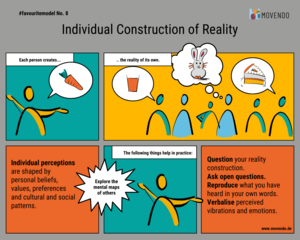#favouritemodel No.8 - Individual Construction of Reality

These neurological filters are enormously important for a quick reaction on your part. If you were to actually perceive all the sensations at every moment, you would simply go insane. At the same time, this process makes communication and interaction with others incredibly complex and challenging. Thus each person, as a unique observer of her environment, creates her own "individual reality".
Imagine that you and I are at the same time, in the same place, looking at the same situation. If each of us filters 200 bits out of the 11 million bits, then the probability that my selection corresponds exactly to your selection is zero. My selection is my small slice of reality and becomes my individual reality. Whereas your reality is very likely to be quite different. Just as a map never represents the actual reality with all its details, our own mental maps also represent only excerpts.
What shapes your reality and how do I shape my reality?
What and how we perceive something is shaped on the one hand by our cultural and social patterns. For example, the issue of punctuality is interpreted and lived differently in different cultures.
An employee whose former supervisor tended to micromanage is likely to respond to his new supervisor's question about how he is progressing in the project with a very detailed report on the individual work steps. While another employee will only answer with a " Well going!"
In addition, personal beliefs, values and preferences formed in the course of life history play a major role in our construction of reality: they distort, erase and generalize information from the environment and thus form your, as well as my, mental map of reality. In short, my reality is not your reality and vice versa.
This makes cooperation and especially communication between two or more people challenging in many cases. How can we come to a common ground when we have a completely different understanding of what is THE reality?
How my #favouritemodel helps you
If you are aware that your view of things does not correspond to the perception, the interpretation of your colleagues, then this means that you have to invest a lot more time in exploring the different mental maps and aligning them with each other. This is the only way to ensure that you are on the same page and pulling in the same direction. In practice, the following things can help you:
- Check your inner attitude - "The reality of others looks different from my reality".
- Question your reality construction - what did you perceive with your senses and where do your experiences and beliefs distort your image and are they helpful or rather hindering in this moment? How would an outsider see the situation?
- Ask open questions - who, what, when and what for? To learn more about your counterpart's reality on the one hand and to help your counterpart sharpen his or her mental map on the other.
- Paraphrase and verbalise - summarise in your own words what you understood as the core message and what you heard and felt between the lines. Verbalise what vibrations and emotions you perceived.
- In virtual meetings - use the camera and microphone and ask your colleagues to do the same - this way you avoid having your perception further distorted by a technical filter.











